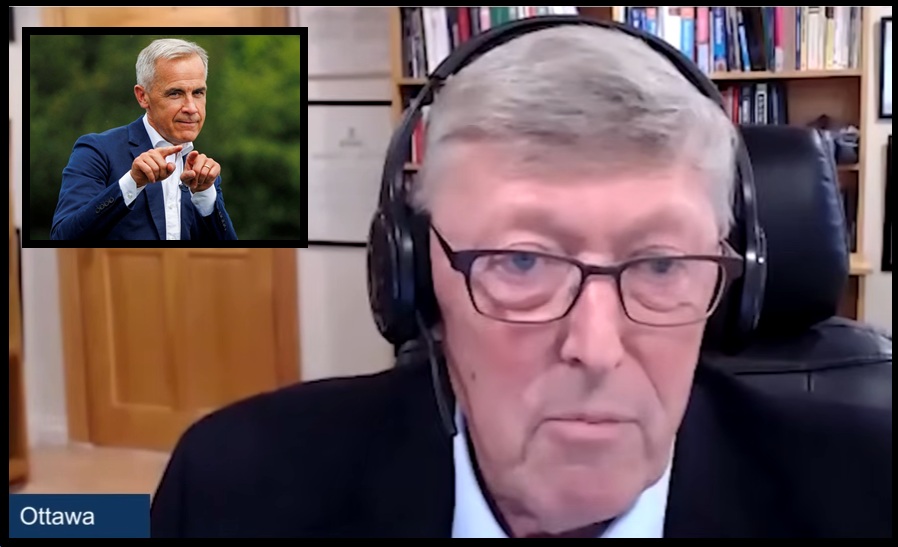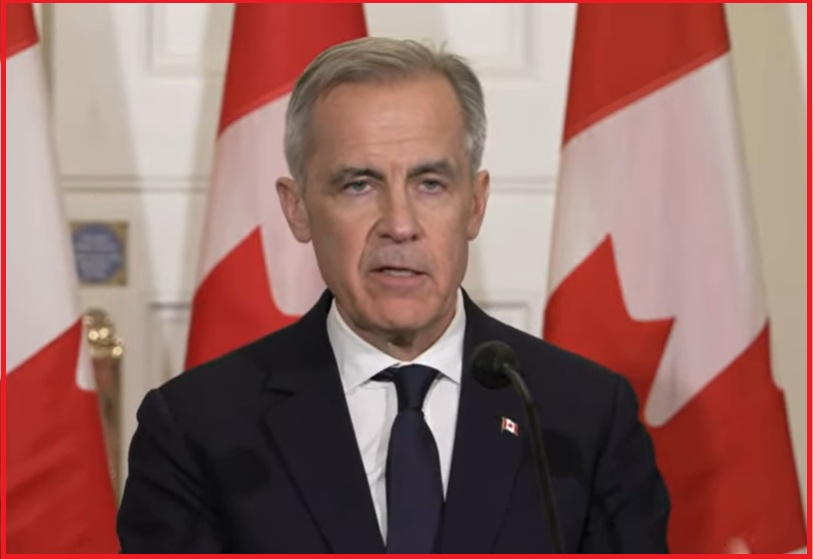In Canada they call the USMCA trade agreement “CUSMA” putting Canada first. President Trump calls it the USMCA because that’s the order of sequence when the trade negotiations took place, the USA then came Mexico and much later, Canada. However, Trudeau used his typical Alinsky gaslighting to pretend Canada was always participating; they were not, they came in at the end.
That said, the former NAFTA trade negotiator for Canada, John Weekes, has finally realized President Trump does not intend to renew or renegotiate the USMCA, he intends to dissolve it in favor of two bilateral free trade agreements; one with Mexico and one with Canada.
I’m not sure what finally, and I do mean FINALLY, triggered a Canadian to realize this, but perhaps they finally listened to President Trump telling Canadian Prime Minister Mark Carney [IN MAY] he intends to end it. DUH! WATCH:
The reality of the U.S-Canada economic relationship and the position of President Donald Trump is not that difficult to understand if you take all the disparate datapoints and quotes from Trump and put them into context.
During a White House meeting with Mark Carney, President Trump essentially told the Canadian Prime Minister why he was in no hurry to get to a deal with Canada. The 35% tariffs on non-USMCA goods triggered August 1st because the main priority of Trump -looking toward Canada- is to dissolve the USMCA.
 During the May 6th oval office meeting with Carney, President Trump was discussing the USMCA and said: “As you know it terminates fairly shortly. It gets renegotiated fairly shortly.” … “This was a transitional deal, and we’ll see what happens, we’re going to start renegotiating that” … “I don’t know if it serves a purpose anymore.” …. “And the biggest purpose it served was, we got rid of NAFTA.”
During the May 6th oval office meeting with Carney, President Trump was discussing the USMCA and said: “As you know it terminates fairly shortly. It gets renegotiated fairly shortly.” … “This was a transitional deal, and we’ll see what happens, we’re going to start renegotiating that” … “I don’t know if it serves a purpose anymore.” …. “And the biggest purpose it served was, we got rid of NAFTA.”
To understand why President Trump wants to dissolve the USMCA {SEE HERE}. To understand the technical value of dissolving the USMCA {SEE HERE}. It’s not a complicated economic analysis; it’s common sense.
Currently, approximately 60% of the traded goods and services between the U.S. and Canada are covered by the USMCA; the remaining 40% was hit by tariffs on August 1st at a 35% rate.
When the USMCA is renegotiated, predictably dissolved in favor of two bilateral trade agreements – one for Mexico and one for Canada, all of the U.S-Canada trade sectors will be part of the enlarged free trade negotiation. As a result, there is absolutely no motive to engage in trade discussions now.
♦ President Trump’s position is essentially to talk about the details when the USMCA is dissolved; hence, the ambivalence.
The certainty the Canadians are looking for can be found easily if they stop pretending.
(1) U.S. tariffs against non-USMCA products from Canada went into effect on August 1st. (2) As soon as the USMCA is reopened, it will be dissolved. (3) After the USMCA dissolution, a bilateral free trade agreement between the USA and Canada will be negotiated.
Every current effort by Canada to change the nature of the trade system, between now and the reopening of the USMCA (to dissolve it), is futile.
Again, I’m not exactly sure why this reality is so challenging for the Canadian govt to understand this, but at least John Weekes is starting to find a clue.
This is where it becomes important to understand the core reason why Trump, Ross and Lighthizer (2017) did not structurally want to replace the NAFTA agreement with another trilateral trade deal. Mexico and Canada are completely different as it pertains to trade with the USA. President Trump would rather have two separate bilateral agreements; one for Mexico and one for Canada.
♦ Firstly, Canada is a NATO partner, Mexico is not. As President Trump affirmed to Justin Trudeau during the meeting, it would be unfair of President Trump to discuss NATO funding with the European Union, while Canada is one of the worst offenders. Trump is leveraging favorable trade terms and tariff relief with the EU member states, as a carrot to get them into compliance with the 2.0 to 2.5% spending requirement for their military.
If the NATO member states contribute more to their own defense, the U.S. can pull back spending and save Americans money. However, Canada is currently 26th in NATO funding, spending only 1.37% of their GDP on defense (link).
Canada would have to spend at least another $15 billion/yr on their defense programs in order to reach 2.0%. Justin Trudeau told President Trump that was an impossible goal given the nature of the Canadian political system, and the current size of their economy ($2.25 trillion).
♦ Secondly, over the last 40 years Canada has deindustrialized their economy, Mexico has not. As the progressive political ideology of their politicians took control of Canada policy, the ‘climate change’ agenda and ‘green’ economy became their focus. The dirty industrialized systems were not compliant with the goals of the Canadian policy makers.
The dirty mining sector (coal, coking coal, ore) no longer exists at scale to support self-sufficient manufacturing. The dirty oil refineries do not exist to refine the crude oil they extract. Large industrial heavy industry no longer exists at a scale needed to be self-sufficient. Instead, Canada purchases forged and rolled steel component parts from overseas (mostly China). Making the issue more challenging, Canada doesn’t even have enough people skilled to do the dirty jobs within the heavy manufacturing; they would need a national apprenticeship program. Again, all points raised by Trudeau to explain why bilateral trade compliance was impossible.
♦ Thirdly, the trade between Canada/U. S and Mexico/U. S is entirely different. The main imports from Canada are energy, lumber and raw materials. The main imports from Mexico are agriculture, cars and finished industrial goods. Mexico refines its own oil; Canada ships their oil to the USA for refining. There are obviously some similar products from Mexico and Canada, but for the most part there is a big difference.
♦ Forth, USA banks are allowed to operate in Mexico, but USA banks are not allowed to operate in Canada. USA media organizations are allowed to broadcast in Mexico, but USA media organizations are regulated and not permitted to broadcast in Canada. The Canadian government has strong regulations and restrictions on information and Intellectual Property.
All of these points of difference highlight why a trilateral trade agreement like NAFTA and the USMCA just don’t work out for the USA.
 Additionally, if President Trump levies a tariff on Chinese imports, it hits Canada much harder than Mexico because Canada has deindustrialized and now imports from China to assemble into finished goods destined to the USA. In a very direct way Canada is a passthrough for Chinese products. Canada is now more of an assembly economy, not a dirty job manufacturing economy.
Additionally, if President Trump levies a tariff on Chinese imports, it hits Canada much harder than Mexico because Canada has deindustrialized and now imports from China to assemble into finished goods destined to the USA. In a very direct way Canada is a passthrough for Chinese products. Canada is now more of an assembly economy, not a dirty job manufacturing economy.
When Trudeau outlines the inability of Canada to agree to trade terms, simply because his country no longer has the capability of adhering to those trade terms, a frustrated President Trump says, “then become a state.”
There is no option to remain taking advantage of the USA on this level, and things are only getting worse. Thus, the point of irreconcilable conflict is identified.
Because the Canadian government became so dependent on their role as an assembly economy, they enmeshed with China in a way that made them dependent. The political issues of Chinese influence within Canada are a direct result of this dynamic. In fact, China was the big winner from the outcome of the recent election because all of their investments into Canada are grounded on retaining Liberal government dependency.
If Trump targets China with punitive tariffs, the Canadian economy will be collaterally damaged. Canada will end up paying a tariff rate because they use cheap Chinese component parts in their finished goods. Canada has structurally designed their economy to do this over multiple years.
Understanding the unique nature of the Canadian economic conundrum, the only way to address the issue is to break out the USMCA into two separate bilateral trade agreements. One set of trade terms for Mexico that leverages border security, and one set of trade terms for Canada that leverages NATO security and border security. The only substantive similarity between them will be in the auto and agriculture sector.
If you think the multinational corporations, political leftists and UniParty Republicans in the USA are strongly opposing Trump now, just wait until the Trump administration officially proposes the elimination of the trilateral North American trade agreement, USMCA.
According to the World Bank, the USA economy is $27.3 trillion. Canada is $2.1 trillion.
Do the math!
Put your elbows up if you need to.



